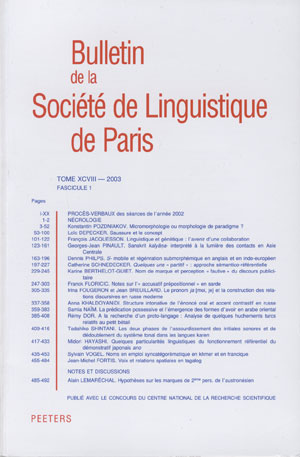 previous article in this issue previous article in this issue | next article in this issue  |

Preview first page |
Document Details : Title: La transcatégorialité Subtitle: Une histoire de limite sans limite Author(s): DO-HURINVILLE, Đanh Thành , DAO, Huy Linh Journal: Bulletin de la Société de Linguistique de Paris Volume: 111 Issue: 1 Date: 2016 Pages: 157-211 DOI: 10.2143/BSL.111.1.3197367 Abstract : Cet article est composé de deux grandes parties. La première comporte cinq points. Dans le premier point, nous revisitons la notion de transcatégorialité, d’une part sous l’angle linguistique (la transcatégorialité respectivement dans les langues flexionnelles, isolantes et agglutinantes), d’autre part sous l’angle métaphysique. Le deuxième point porte sur une précision terminologique. Le troisième point présente, d’une part les relations entre les deux processus, grammaticalisation et pragmaticalisation (la seconde fait-elle partie de la première? Constitue-t-elle un sous-type de la première, ou un autre processus?), d’autre part les traits définitoires des pragmatèmes. Dans le quatrième point, nous proposons un modèle dynamique et interactif de forme triangulaire du fonctionnement des unités transcatégorielles (lexème, grammèmes, pragmatèmes). Dans le cinquième et dernier point nous examimons succinctement trois tendances de l’économie en français actuel (adjectifs en emploi adverbial; noms en emploi d’épithète; noms en emploi prépositionnel). La seconde grande partie, consacrée à une étude de l’unité transcatégorielle «limite», contient trois points. Dans le premier point, nous nous penchons sur «limite» comme lexème, en vue d’une comparaison avec le lexème «frontière», et sur les syntagmes prépositionnels «à la limite de SN» et «à la frontière de SN». Nous examinons, dans le deuxième point, le fonctionnement de «limite» en qualité de grammème: nous expliquons le passage de «à la limite de SN» à «limite - adjectif», puis étudions «limite» comme modifieur d’adjectifs, de noms, de verbes, et «limite» suivi de syntagmes prépositionnels ou de propositions; nous procédons ensuite à une brève étude comparative entre «limite», «presque» et «voire». Le troisième et dernier point est dédié à une analyse de quelques exemples dans lesquels «limite» se comporte comme un pragmatème. This paper is composed of two major parts. The first part consists in five points. First, we revise the notion of transcategoriality from the linguistic point of view (transcategoriality being examined in flexional, isolating and agglutinating languages, respectively), as well as from the metaphysical viewpoint. Second, we discuss some terminological issues related to the concept of transcategoriality. Third, we examine the relationship between grammaticalisation and pragmaticalisation (Is subsidiary to the former? Is it a subtype or a separate process?), on the one hand, and single out a number of defining features of pragmatemes, on the other. Fourth, we put forward a dynamic and interactive model in order to account for the behavior of transcategorial items (lexemes, grammemes, pragmatemes). And finally, we briefly present three tendencies of categorial economy in modern French (adjectives in adverbial use, noun adjuncts/attributive nouns, nouns functioning as prepositions). The second part, devoted to the study of the transcategorial marker 'limite' (Engl. 'limit') , is made of three points. In the first point, we take a close look at 'limite' in its uses as a lexeme and compare it to the lexeme 'frontière', before examining the prepositional phrases containing them, namely 'à la limite de NP' and 'à la frontière de NP'. The second point deals with the behaviour of 'limite' as a grammeme. We try to explain the transition from 'à la limite de NP' to 'limite — ADJ', then examine the modifier function of 'limite' when it is immediately followed by an adjective, a noun, a verb, a prepositional phrase, or a clause. This section is complemented by a brief comparative study of 'limite', 'presque' and 'voire'. The third and last point analyses some examples in which 'limite' functions as a pragmateme. |
|


